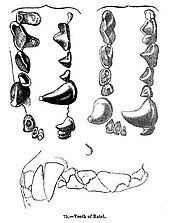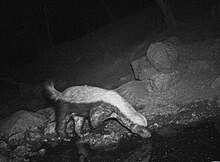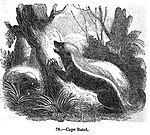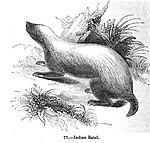Honey badger
| Honey badger Temporal range: middle Pliocene – Recent
| |
|---|---|

| |
| In Kruger National Park, South Africa | |
| Scientific classification | |
| Domain: | Eukaryota |
| Kingdom: | Animalia |
| Phylum: | Chordata |
| Class: | Mammalia |
| Order: | Carnivora |
| Family: | Mustelidae |
| Subfamily: | Mellivorinae
|
| Genus: | Mellivora |
| Species: | M. capensis
|
| Binomial name | |
| Mellivora capensis (Schreber, 1776)
| |

| |
| Ratel distribution
Extant (resident)
| |
The honey badger (Mellivora capensis), also known as the ratel (
It is the only living
Taxonomy
Viverra capensis was the
The honey badger is the
Evolution
The species first appeared during the middle Pliocene in Asia.[6] A number of extinct relatives are known dating back at least 7 million years to the Late Miocene. These include Mellivora benfieldi from South Africa and Italy, Promellivora from Pakistan, and Howellictis from Chad. More distant relatives include Eomellivora, which evolved into several different species in both the Old and New World, and the giant, long-legged Ekorus from Kenya.[7]
Subspecies
In the 19th and 20th centuries, 16 zoological specimens of the honey badger were described and proposed as subspecies.[8] As of 2005[update], 12 subspecies are recognised as valid taxa.[9] Points taken into consideration in assigning different subspecies include size and the extent of whiteness or greyness on the back.[10]
| Subspecies and authority | Description | Range | Synonyms |
|---|---|---|---|
| Cape ratel (M. c. capensis) (Schreber, 1776) | South and southwestern Africa | mellivorus (Cuvier, 1798) ratel (Sparrman, 1777) | |
| Indian ratel (M. c. indica) (Kerr, 1792) | Distinguished from capensis by its smaller size, paler fur and having a less distinct lateral white band separating the upper white and lower black areas of the body[11] | Western former Soviet Union , its range includes Afghanistan, Iran (except the southwestern part), western Pakistan and western India
|
mellivorus (Bennett, 1830) ratel (Horsfield, 1851) |
| Nepalese ratel (M. c. inaurita) (Hodgson, 1836) | Distinguished from indica by its longer, much woollier coat and having overgrown hair on its heels[12] | Nepal and contiguous areas east of it | |
| White-backed ratel (M. c. leuconota) (Sclater, 1867) | The entire upper side from the face to half-way along the tail is pure creamy white with little admixture of black hairs[13] | West Africa, southern Morocco, former French Congo | |
| Black ratel (M. c. cottoni) (Lydekker, 1906) | The fur is typically entirely black, with thin and harsh hairs.[13] | Ghana, northeastern Congo | sagulata (Hollister, 1910) |
| Lake Chad ratel (M. c. concisa) (Thomas and Wroughton, 1907) | The coat on the back consists largely of very long, pure white bristle-hairs amongst long, fine, black underfur. Its distinguishing feature from other subspecies is the lack of the usual white bristle-hairs in the lumbar area[13] | Sahel and Sudan zones, as far as Somaliland | brockmani (Wroughton and Cheesman, 1920) buchanani (Thomas, 1925) |
| Speckled ratel (M. c. signata) (Pocock, 1909) | Although its pelage is the normal dense white over the crown, this pale colour starts to thin out over the neck and shoulders, continuing to the rump where it fades into black. It possesses an extra lower molar on the left side of the jaw[13] | Sierra Leone | |
| Ethiopian ratel (M. c. abyssinica) (Hollister, 1910) | Ethiopia | ||
| Persian ratel (M. c. wilsoni) (Cheesman, 1920) | Southwestern Iran and Iraq | ||
| Kenyan ratel (M. c. maxwelli) (Thomas, 1923) | Kenya | ||
| Arabian ratel (M. c. pumilio) Pocock, 1946[14] | Arabia
|
||
| Turkmenian ratel (M. c. buechneri) Baryshnikov, 2000 | Similar to the subspecies indica and inaurita, but is distinguished by its larger size and narrower postorbital constriction[15] | Turkmenistan |
Description
The honey badger has a fairly long body, but is distinctly thick-set and broad across the back. Its skin is remarkably loose, and allows the animal to turn and twist freely within it.
The honey badger has short and sturdy legs, with five toes on each foot. The feet are armed with very strong claws, which are short on the hind legs and remarkably long on the forelimbs. It is a partially plantigrade animal whose soles are thickly padded and naked up to the wrists. The tail is short and is covered in long hairs, save for below the base.
The honey badger is the largest terrestrial mustelid in Africa. Adults measure 23 to 28 cm (9.1 to 11.0 in) in shoulder height and 55–77 cm (22–30 in) in body length, with the tail adding another 12–30 cm (4.7–11.8 in). Females are smaller than males.[16] In Africa, males weigh 9 to 16 kg (20 to 35 lb) while females weigh 5 to 10 kg (11 to 22 lb) on average. The mean weight of adult honey badgers from different areas has been reported at anywhere between 6.4 to 12 kg (14 to 26 lb), with a median of roughly 9 kg (20 lb), per various studies. This positions it as the third largest known badger, after the European badger and hog badger, and fourth largest extant terrestrial mustelid after additionally the wolverine.[8][18][19][20][21] However, the average weight of three wild females from Iraq was reported as 18 kg (40 lb), about the typical weight of male wolverines or male European badgers in late autumn, indicating that they can attain much larger than typical sizes in favorable conditions.[22][23] However, an adult female and two males in India were relatively small weighing 6.4 kg (14 lb) and a median of 8.4 kg (19 lb).[8] Skull length is 13.9–14.5 cm (5.5–5.7 in) in males and 13 cm (5.1 in) for females.[24]
There are two pairs of

The skull greatly resembles a larger version of that of a marbled polecat.[28] The
The winter fur is long, being 40–50 mm (1.6–2.0 in) long on the lower back, and consists of sparse, coarse, bristle-like hairs, with minimal
Distribution and habitat

The honey badger ranges through most of
Behaviour and ecology

The honey badger is mostly solitary, but has also been sighted in Africa to hunt in pairs during the
It is a skilled digger, able to dig tunnels into hard ground in 10 minutes. These burrows usually have only one entry, are usually only 1–3 m (3 ft 3 in – 9 ft 10 in) long with a nesting chamber that is not lined with any bedding.[32]The honey badger is famous for its strength, ferocity and toughness. It is known to savagely and fearlessly attack almost any other species when escape is impossible, reportedly even repelling much larger predators such as
Diet

The honey badger has the least specialised diet of the weasel family next to the wolverine.[17] It accesses a large part of its food by digging it out of burrows.[8] It often raids
Despite popular belief, there is no evidence that honeyguides guide the honey badger.[43]
Reproduction
Little is known of the honey badger's breeding habits. Its
Relationships with humans
Honey badgers often become serious poultry predators. Because of their strength and persistence, they are difficult to deter. They are known to rip thick planks from hen-houses or burrow underneath stone foundations. Surplus killing is common during these events, with one incident resulting in the death of 17 Muscovy ducks and 36 chickens.[30]
Because of the toughness and looseness of their skin, honey badgers are very difficult to hunt with dogs. Their skin is hard to penetrate, and its looseness allows them to twist and turn on their attackers when held. The only safe grip on a honey badger is on the back of the neck.[46]
During the British occupation of Basra in 2007, rumours of "man-eating badgers" emerged from the local population, including allegations that these beasts were released by the British troops, something that the British categorically denied.[47][48] A British army spokesperson said that the badgers were "native to the region but rare in Iraq" and "are usually only dangerous to humans if provoked".[49]
The honey badger has also been reported to dig up human corpses in India.[11] In Kenya, the honey badger is a major reservoir of rabies[50][51] and is suspected to be a significant contributor to the sylvatic cycle of the disease.[52]
References
- ^ . Retrieved 19 November 2021.
- ^ Schreber, J. C. D. (1777). "Das Stinkbinksen". Die Säugethiere in Abbildungen nach der Natur mit Beschreibungen. Erlangen: Wolfgang Walther. pp. 450–451.
- ^ Storr, G. C. C. (1780). "Mellivorae". Prodromus methodi mammalium. Tübingen: Reiss. p. 34.
- ^ Gray, J. E. (1865). "Revision of the genera and species of Mustelidae contained in the British Museum". Proceedings of the Zoological Society of London: 100–154.
- PMID 18275614.
- ^ Heptner & Sludskii 2002, pp. 1209–1210
- S2CID 227249176.
- ^ doi:10.1644/0.721.1.
- OCLC 62265494.
- ^ a b c Rosevear 1974, p. 123
- ^ a b Pocock, R. I. (1941). "Mellivora capensis (Schreber)". Fauna of British India. Vol. Volume 2. Mammals. London: Taylor and Francis. pp. 456–466.
- ^ Pocock 1941, p. 462
- ^ a b c d e Rosevear 1974, pp. 126–127
- .
- .
- ^ a b c Rosevear 1974, p. 113
- ^ a b c Kingdon 1989, p. 87
- .
- PMID 17492976.
- . Retrieved 20 October 2020.
- ^ Ahasan, S. A.; Iqbal, M. S. & Shakif-Ul-Azam, M. (2010). "Prevalence of parasitic infestations in captive wild carnivores at Dhaka Zoo" (PDF). Zoo's Print. 25 (6): 34.[permanent dead link]
- S2CID 56433126.
- ^ Mohammed, A. H. S.; Haider, S. K. & Salman, R. A. (2014). "Morphological study of the lingual papillae in Mellivora capensis tongue" (PDF). Journal of US-China Medical Science. 11 (1): 42–46.
- ^ Heptner & Sludskii 2002, pp. 1216–1217
- ^ Pocock 1941, p. 456
- ^ Ewer 1973, p. 98
- ^ Kingdon 1989, p. 89
- ^ Pocock 1941, p. 1214
- ^ a b Rosevear 1974, pp. 114–16
- ^ a b c d Rosevear 1974, pp. 117–118
- ^ Heptner & Sludskii 2002, p. 1213
- ^ Heptner & Sludskii 2002, p. 1225
- ISBN 978-0-691-15228-8.
- .
- doi:10.1111/j.1469-7998.2006.00139.x. Archived from the original(PDF) on 5 November 2012. Retrieved 29 January 2019.
- ^ a b Begg, C. M. (2001). Feeding ecology and social organisation of honey badgers (Mellivora capensis) in the southern Kalahari (Doctoral dissertation). Pretoria: University of Pretoria.
- ^ Stievater, B. (26 June 2019). "Beehive Fences to Deter Both Elephants and Honey Badgers". wildnet.org. Retrieved 6 September 2020.
- ^ Rosevear 1974, p. 120
- S2CID 59584904. Archived from the original(PDF) on 1 August 2020.
- ^ Hoesch, W. (1964). "Beobachtungen an einem zahmen Honigdachs (Mellivora capensis)". Zoologischer Garten. 28 (4): 182–188.
- .
- ^ Pocock 1941, p. 464
- .
- ^ Heptner & Sludskii 2002, p. 1228
- ^ Pocock 1941, p. 465
- ^ Rosevear 1974, p. 116
- ^ Philp, Catherine (12 July 2007). "Bombs, guns, gangs – now Basra falls prey to the monster badger". The Times. Archived from the original on 15 August 2007. Retrieved 19 June 2023.
- ^ "British blamed for Basra badgers BBC News". BBC News. 12 July 2007. Retrieved 19 June 2023.
- ^ Baker, Graeme (12 July 2007). "British troops blamed for badger plague". The Telegraph. Retrieved 19 June 2023.
- ISBN 978-0-521-89109-7.
- ^ Chong, W. K. RABIES IN KENYA Archived 13 May 2013 at the Wayback Machine, Southern and Eastern African Rabies Group
- ISBN 978-3-642-22871-1.
Further reading
- Ewer, R. F. (1973). The Carnivores. Cornell University Press. ISBN 978-0-8014-8493-3.
- Heptner, V. G.; Sludskii, A. A. (2002). Mammals of the Soviet Union. Vol. II, part 1b, Carnivores (Mustelidae). Washington, D.C.: Smithsonian Institution Libraries and National Science Foundation. ISBN 978-90-04-08876-4.
- Kingdon, J. (1989). East African mammals. Vol. Volume 3 : an atlas of evolution in Africa. Chicago: University of Chicago Press. ISBN 978-0-226-43721-7.
- Rosevear, D. R. (1974). The Carnivores of West Africa. London: ISBN 978-0-565-00723-2.




